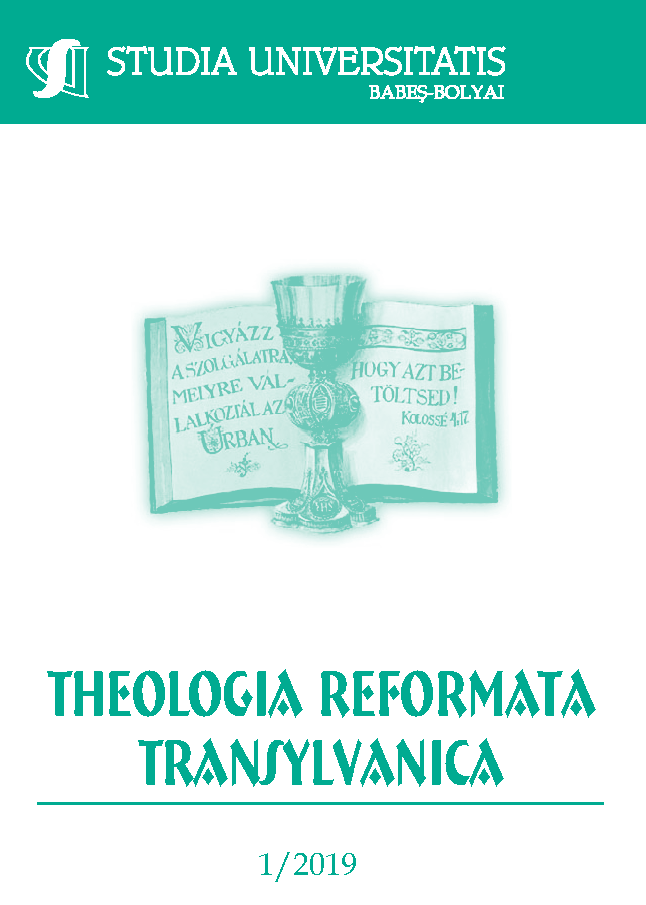A katakombafestmények mint „vizuális prédikációk” értelmezése
DOI:
https://doi.org/10.24193/subbtref.64.1.17Keywords:
Catacomb Paintings, visual sermons, frescos, iconography, Christian symbolAbstract
The Interpretation of Catacomb Paintings as „Visual Sermons” .
Several viewpoints took shape about the pictures and icons during the history of Christianity. The image representations have been subject to debate not only among religions but among the various Christian approaches, too. This debate flamed up quite strongly in different times in history. The study aims to determine the extent to which the icons and representations are rooted in Christian tradition. The study points out that early Christian art did not appear and develop in a void. It was the outward manifestation of a new spirituality as well as the result of a development process that occurred when the local cultures of the ancient world got in contact with each other. It is essential to point out that in icon painting as well as in the paintings in the catacombs the message of the icons was also perfectly grasped by those who did not study painting or were not very skillful painters, but still observed the iconographic traditions while those who the painting were addressed to accepted them. One can assess Early Christian art by the very few frescos remaining in the catacombs in Rome. They used pagan symbols as well as some themes of Greek and Roman mythology in order to convey the teachings of the church. They also used the ancient forms of art, loading them with a new content subsequently altering the respective forms as well. The art of the catacombs was actually dogmatic art since the theme depicted on the frescos mostly followed the texts of the scripture. Furthermore, the symbolic language had a paramount importance. The works of art created in the first centuries can also be considered as “visual sermons” that helped them explain God verbally and drive them to God.
References
Az ikonfestés elmélete és gyakorlata. Tanári jegyzet. Készítették: GÁBOR Bálint József O. Praem – MURAINÉ DANCS Jeanette. A jegyezet Egon SENDLER The Icon, Image of the Invisible, Elements of Theology, Aesthetics and Technique, transl. Steven Bigham, Oakwood Publications, 1984 c. munkája alapján készült.
BUGÁR M. István: Szakráls Képzőművészet a keresztyén ókorban. I. kötet, Paulus Hungarus–Kairosz Kiadó, Budapest, 2004.
CHADWICK, Henry: A korai egyház, Osiris Kiadó, Budapest, 2003.
ÉBER László: Európa művészete, in: ÉBER László – FELVINCZI TAKÁCS Zoltán – BARÁT Béla: A művészet története, Dante Könyvkiadó, Budapest, 1939.
EFFENBERGER, Arne: Frühchristliche Kunst und Kultur. Von den Anfängen bis zum 7. Jah-rhundert, Verlag C. H. Beck, München, 1986.
FERGUSON, Everett: A kereszténység bölcsője, Osiris, Budapest, 1999.
Dr. FOLTIN Brúnó: Jézus feltámadása. Húsvéti meditáció az énekeskönyvünk 219. sz. éneke alapján, in Evangélikus Élet, 1998. április 12. 3. https://library.hungaricana.hu/hu/view/EvangelikusElet_1998/?pg=86&layout=s (Utolsó letöltés: 2018. december 8.)
Glauben im Untergrund. Die Katakomben Roms. Vor den Toren Roms erstreckt sich eine unterirdische Stadt der Toten. Die gewaltigen Grabanlagen der Katakomben bewahren die wichtigsten Zeugnisse der frühen Christen, https://www.g-geschichte.de/plus/die-katakomben-roms
GRABAR, Andre: The Beginnings of Christian Art, 200–395 (Arts of Mankind 9.), Tha-mes&Hudson, London, 1967.
HOLLINGSWORTH, Mary: Művészetek világtörténete, Akadémiai Kiadó, Budapest, 1995.
HOPPÁL Mihály – JANKOVICS Marcell – NAGY András – SZEMADÁM György: Jelképtár, Helikon Kiadó, Budapest, 2010.
JANKOVICS Marcell: Jelkép-kalendárium, Csokonai Kiadó, [Debrecen], 1997.
KÁDÁR Zoltán: Katakomba (szócikk) in: DIÓS István – VICZIÁN János (szerk.): Magyar Katolikus Lexikon, VI. kötet, Szent István Társulat, Budapest, 2007.
KOCH, Wilfried: Építészeti stílusok, Officina Nova, Magyar Könyvklub, Budapest, 1997.
LADÁNYI Sándor: A keresztények hitének próbája, in: A kereszténység krónikája, Officina Nova, Budapest, 1998.
LA PIANA, George: The Roman Church at the End of the Second Century, in: HTR 18:3, 1925. 270.
MIGGE, Thomas: Frühe Christen unter der Erde. Die Marcellinus-Katakombe in Rom ist wieder zugänglich, előadás, 2014. május 5. https://www.deutschlandfunkkultur.de/fruehe-christen-heiligenbilder-unter-der erde.1278.de.html?dram:article_id=285007 (Utolsó letöltés: 2018. november 9.)
NAGYMIHÁLYI Géza: Az angyalok. Liturgia és ikon a keresztyén keleten, Paulus Hungarus–Kairosz Kiadó, 2002.
NAGYMIHÁLYI Géza: Képtisztelet a bizánci kereszténységben, in: XERAVITS Géza (szerk.): Ikonográfia ökumenikus megközelítésben, PRTA–L'Harmattan, Pápa–Bp., 2005.
PECSUK Otto: Pál és a rómaiak. A Római levél kortörténeti olvasata (Doktori disszertáció). Kálvin Kiadó, Budapest, 2009.
PECSUK Ottó: A katakombák rejtélye, in: Harangszó, 2014. január, 2. szám. 4.
PÜSÖK Sarolta: Művészet, képrombolás, reformáció és a képi megjelenés jogosultságáról, in: Studia Reformata Transylvaniensis, Kolozsvár, 2001/1. 139-149.
RÉVÉSZ Imre-SEGESVÁRY Lajos: Az Egyháztörténelem alapvonalai, Városi Nyomda, Debrecen, 1936.
RIES, Julien: A hívő ember a zsidó, keresztény és az iszlám vallásban, Typotex Kiadó, Buda-pest, 2006.
SCHULTZE, Victor: Die Katakomben: Die Altchristlichen Grabstätten – Ihre Geschichte und Ihre Monumente, Severus Verlag, Hamburg, 2013.
SEIBERT, Jutta (szerk.): A keresztény művészet lexikona, Corvina Kiadó, Budapest, 1986.
SZÁNTÓ Konrád: A katolikus egyház története, I. kötet, Ecclesia Kiadó, Budapest, 1987.
USZPENSZKIJ, Leonyid: Az ikon teológiája az ortodox egyházban, Kairosz–Paulus Hungarus, Budapest, 2003.
VANYÓ László: Az ókeresztény művészet szimbólumai, Jel Kiadó, Budapest, 2010.
WISEMAN Miklós: Fabiola, vagy a katakombák egyháza, (ford. Holló Miklós) Szent István Társulat, Pest, 1856.
XERAVITS Géza: Ikonográfia, Baán István: A képtisztelet dogmatörténeti háttere, in: Uő. (szerk.): Ikonográfia ökumenikus megközelítésben, PRTA–L'Harmattan, Pápa–Budapest, 2005.
Downloads
Published
How to Cite
Issue
Section
License
Copyright (c) 2019 Studia Universitatis Babeș-Bolyai Theologia Reformata Transylvanica

This work is licensed under a Creative Commons Attribution-NonCommercial-NoDerivatives 4.0 International License.






